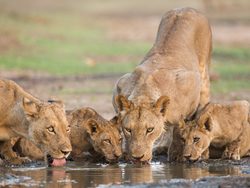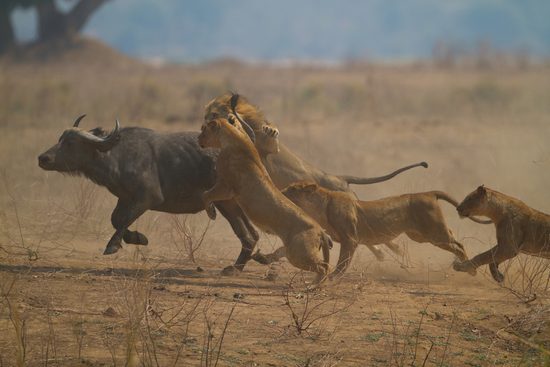
Quick Navigation
Mana Pools National Park is located in Zimbabwe along the Zambezi River and the border of Zambia. The park covers an area of 2,612 square miles (6,766 sq km).
This broad plain area generates a series of lakes during the rainy season. As the waters begin to recede, the remaining pools become excellent game viewing locations as wildlife flocks to these natural watering holes. It is these remaining pools that draw the animals and create this spectacular game viewing setting.
The Mana Pools were combined with the Sapi Safari Area and Chewore Safari Area to create a single UNESCO World Heritage site in 1984. It is also classified as a wetland of international importance by Ramsar. The national park area is also contiguous with Zambia’s Lower Zambezi National Park. Unfortunately, it is not easy to travel between the two parks.
The remoteness of the Mana Pools helps travelers engage the true sense of a wilderness experience while also increasing the intrigue and adventure of discovering Africa.
Although there will be more than four pools at different times based on the rainfall, there are four pools that are recognized as permanent in the area. In a local language, the word "mana" means four. The four permanent watering holes or pools are where the park draws its name.
The banks of the river beds and the pools give way to lush forests of acacia, baobabs, ebonies, fig, and mahogany trees. The pools are also home to Zimbabwe's largest population of hippos and crocodiles. During the dry season, these are easily seen lining the banks of the pools sunning or grazing.
The dry season brings herds of elephant, buffalo, zebra, eland, waterbuck, antelope, and other ungulates to the pools for drinking water. This means it is an excellent place to find the predator species of cheetah, hyena, leopard, lion, and wild dog waiting to pounce on vulnerable prey.
Although the rhino used to graze amongst the mana pools, poachers have led it to extinction for the area. The other four of the Big 5, (lion, leopard, elephant, and buffalo, can all be found in the park boundaries.
Birdwatchers will also enjoy the incredible opportunities the Mana Pools provide with over 450 species of birds nesting or migrating through the park area.
Highlights
Traveling to Zimbabwe to visit the Mana Pools National Park between the months of July and October are in for a special treat as wildlife tends to congregate near the pools of the floodplains as the dry season dries up watering holes in other areas.
 Lion, leopard, hyena, and wild dog are the predators that visitors can hope to experience. Elephant, zebra, buffalo, hippopotamus, and crocodile are some of the more popular game species that visitors can hope to see.
Lion, leopard, hyena, and wild dog are the predators that visitors can hope to experience. Elephant, zebra, buffalo, hippopotamus, and crocodile are some of the more popular game species that visitors can hope to see.
One of the unique features of a Mana Pools experience is the ability to encounter and view wildlife from both the land and water. This gives stunning views of the dramatic landscapes as well as different views and perspectives of the wildlife. This increases your chances of seeing more and different wildlife species.
These watering holes are tremendous places to witness wildlife congregating to drink, eat, and survive. For some the water is life sustaining, wheras for others it serves as a trap by pending predators watching for every opportunity to catch their next meal.
Things To Do:
The reason travels visit Zimbabwe is almost always for the wildlife and Mana Pools is one of the most coveted places to visit to experience the abundant animal life.

Game Drive
The most commonly way that people experience the wildlife is from inside a 4x4 safari vehicle. A game drive is one of the best ways to see the greatest number and variety of animals in the park.

Walking Safari
A walking safari is a more intimate encounter with nature. Your guide will take you on a trek that may be in the tracks of wildlife itself. Having an opportunity to see wildlife as you walk or sit in the wild is exhilerating.
Mana Pools Highlights
- Excellent wildlife viewing at the watering holes (Mana Pools)
- Four of the Big 5, no rhinoceroses
- Six-packs of wild dogs, around 100
Park Map
Sources
- Britannica, Mana Pools, https://www.britannica.com/place/Mana-Pools-National-Park, retrieved June 2020.
- Discover Africa, Mana Pools National Park, https://www.discoverafrica.com/safaris/zimbabwe/mana-pools-national-park/, retrieved July 2019
- Safari Bookings, Mana Pools Wildlife, https://www.safaribookings.com/mana-pools/wildlife, retrieved July 2019
- UNESCO, Mana Pools National park, Sapi and Chewore Safari Areas, https://whc.unesco.org/en/list/302/, retrieved July 2019.
- Zambezi, Mana Pools, https://www.zambezi.com/locations/mana-pools/, retrieved June 2020.


























